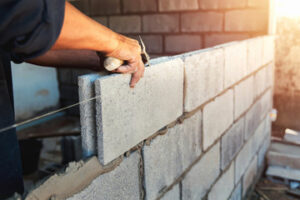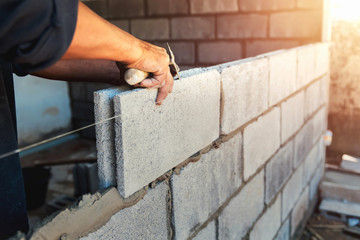Masonry is a craft trade that has long been a part of many cultures across the world. From laying bricks and stone to restoring older structures, masons do many different types of work.
Most masonry is built with building units like stones or bricks that are bound together by mortar. There are several advantages to masonry construction but it can also be costly and time-consuming. By hiring Concrete Contractors Colorado Springs, you’ll save yourself time and money.
 Strength
Strength
Masonry is a great building material for long-lasting walls. It has been used for over 7000 years and has stood up to every type of weather, including hurricanes. This makes masonry a great choice for homes, schools, office buildings, and other structures. There are several options when it comes to masonry construction, including concrete brick, and stone. Masonry can also be a good choice for foundations and columns.
Generally speaking, masonry is strong in compression but weak in tension. For this reason, it is designed to resist the vertical loads that act on a wall from above. Builders took advantage of this feature in olden times by using arches above windows and doors, which allowed the wall loads to transfer to the arch, keeping the lintel in compression rather than in tension.
Modern masonry structures often use post-tensioning to increase the strength of the structure. This technique involves a cable being run through the entire length of the wall, with the ends attached to the concrete base or footings. This increases the tensile strength of the wall and allows it to resist lateral forces from wind and earthquakes.
Another method of increasing the lateral strength of a masonry wall is by adding steel reinforcement. The size of the rebar and its spacing are determined to be appropriate for the structural conditions of the building.
In general, masonry is weak in transverse load and requires substantial bracing and buttressing. It is therefore a poor choice for structures that require large transverse displacements such as parking structures or high-rises.
For masonry walls, the maximum flexural bending stress is limited by the compressive axial force and the modulus of rupture values, which are determined by the test results for uncracked sections. Unlike allowable stress design, which permits deflections to be calculated based on cracked section properties, strength design limits deflections of reinforced and unreinforced masonry elements to one-half the gross section properties, unless a rigorous cracked-section analysis is performed.
In addition to its strength, masonry is non-combustible, which helps prevent fires and reduce energy costs. Additionally, it is relatively low maintenance and offers a beautiful aesthetic. It is a green building product since it uses recycled materials and produces few greenhouse gases during production.
Durability
Masonry has long been known for its durability, and it is particularly resistant to fire. The material also can regulate indoor temperatures, reducing energy consumption and resulting in cost savings. It is also non-combustible, which helps to protect structures from the spread of fire.
The longevity of masonry is determined by the materials used, their quality, and how they are assembled. For instance, a brick wall constructed using mortar is more likely to be durable than a stone wall made from stones without a cement binder. A properly built masonry wall is also resistant to damage caused by wind, storms, and earthquakes.
There are several different types of masonry materials, including concrete blocks, clay bricks, and glass blocks. Concrete block masonry uses precast concrete blocks, which are laid in a pattern and joined together with mortar. This type of masonry is commonly used to build retaining walls, fireplaces, and chimneys. It is also used to construct commercial buildings, bathrooms, and partitions.
Another type of masonry is clay brick, which uses natural clay to create blocks that are then combined with mortar to form a wall. This type of masonry is used to build residential and commercial buildings, as well as public works projects such as dams, bridges, and roadways. It is also often used to build walls and fences for gardens, patios, pools, and other outdoor structures.
Finally, glass block masonry uses tempered or laminated glass to construct walls and skylights. This type of masonry is more durable than other types of masonry because it can resist corrosion, weathering, and other elements.
Choosing the right masonry for your project is essential. The materials should be strong, stiff, and sound enough to withstand the loads placed on them by workers and tools. They should also be free from lumps of lime, laminations, cracks, air holes, soluble salts causing efflorescence, or other defects that could impair their strength, appearance, or utility for the intended purpose.
In addition to its durability, masonry is highly customizable, allowing architects and builders to create unique aesthetic designs. It also requires minimal maintenance compared to other construction materials. Masonry is also environmentally friendly, as the production process releases few greenhouse gases.
Aesthetics
Masonry is known for its color, scale, texture, and pattern as well as a feeling of permanence. It also offers several performance advantages such as controlling sound, resisting fire, and insulating against daily fluctuations in temperature.
Masonry can be used to create walls, partitions, and enclosures as well as outdoor living spaces that meld seamlessly with the surrounding landscape. Even a flat lot can be made interesting with masonry walls that define different areas and create vertical interest.
Brick masonry is the most commonly used type of masonry and comes in a wide variety of sizes, shapes, colors, and textures. Its natural aggregate and sand content produce rich, variegated color and textural characteristics that add character to any building. When a more monotone appearance is desired, several techniques can be utilized to increase the consistency of the finished wall. For example, the use of mineral pigments in the concrete mix can help to eliminate color variations caused by natural aggregate and sand content differences.
Another way to control the aesthetics of a masonry wall is by using a brick veneer. A masonry veneer consists of a structurally independent wall, typically constructed of wood or masonry, that is clad with bricks on one or both sides. This enables the flexibility of a concrete masonry wall with the added benefit of a more attractive façade.
The mortar that fills the joints between masonry units can also play an important role in the aesthetics of the finished wall. While joint filling generally comprises less than ten percent of the total wall surface area, it can have a significant impact on the appearance of a finished structure. The joint filling material, joint finishing, and mortar color can be designed to achieve a particular aesthetic.
Aesthetics can also be enhanced with the proper selection and installation of lighting. The most desirable lighting is diffuse illumination, which does not concentrate a focused beam but rather spreads light to softly illuminate the adjacent wall surface. This is often accomplished with specialized fixtures that are designed to be recessed into or mounted on a masonry wall and that internally refract, reflect, partially block, diffuse, and/or shade the light from directly impinging on the masonry wall surface.
Energy Efficiency
Masonry walls provide excellent insulation, keeping interiors warm in the winter and cool in the summer, reducing energy costs. Masonry walls are more effective in restricting air flow than insulated foam and fiberglass, helping to limit heat loss through the walls.
The thermal mass of masonry helps to stabilize indoor temperatures by absorbing excess solar heat during the day and slowly releasing it at night. This reduces the need for mechanical heating and cooling, resulting in significant energy savings. Masonry walls also provide acoustic insulation, providing quieter and more comfortable environments for occupants.
Brick and stone masonry are inherently fire resistant, helping to protect occupants, the structure of buildings, and valuable belongings. Masonry fire partitions and firewalls can help prevent the spread of fire, minimizing property damage and helping to save lives and reduce insurance premiums.
Load-bearing masonry construction offers the opportunity to build structures with large openings and high vaulted ceilings, as well as a variety of different styles and shapes. This flexibility makes it a popular choice for commercial buildings. Masonry is also a great option for parking garages, allowing for the addition of elevators and stairs without impacting structural integrity.
In terms of cost, masonry is a relatively affordable material for both new construction and retrofits. Its superior strength, durability, and aesthetics make it a great alternative to other materials, such as wood or concrete. Its construction methods allow for more efficient use of space, reducing both labor and material costs.
Additionally, a single contractor is responsible for all load-bearing masonry work on a project, which minimizes labor problems and delays. This also ensures a consistent construction pace, which is critical for keeping a project on schedule and meeting occupancy requirements.
The natural materials in masonry don’t attract insects and can resist mold and mildew growth, saving on maintenance and repair costs. Additionally, the lack of porous surfaces means masonry is less susceptible to water damage than other building materials. Masonry is also a sustainable and environmentally friendly material, requiring little to no energy for manufacture and preventing the depletion of forests and other natural resources.
